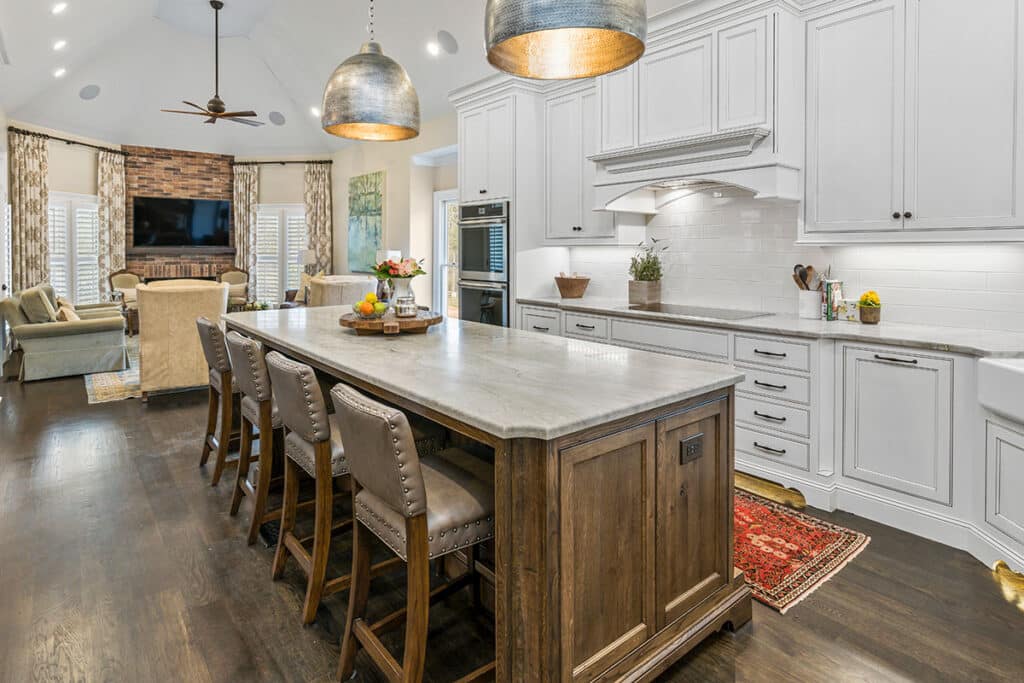
Hundreds of little design choices go into making a functional kitchen. Just ask Julia Child, whose famous kitchen has been preserved in the Smithsonian.
Among the kitchen’s unique features are custom countertops, which are actually thicker than standard– which made chopping, mixing, and kitchen prep much easier and more comfortable for the 6’3” chef. Ergonomics, the science of efficiency in a working environment, is extremely important in the kitchen.
A kitchen where you can’t move and work comfortably is a kitchen that’s deeply uncomfortable to use. And since kitchens are the heart of the home, it’s important to enjoy this space!
One of the ways you can improve your kitchen’s ergonomics is to rethink your countertops. Custom quartzite countertops create a tough, durable surface that’s heat resistant and easy to maintain– but there’s more to quartzite than just choosing the slab. Thickness is important, too! Today, let’s take a look at how quartzite thickness can impact your kitchen’s ergonomics, and what factors go into the choice.

Standard Quartzite Thickness
Stone slabs, including quartzite, typically come in two standard thicknesses: 2 cm and 3 cm. The 2 cm option is lighter and often requires added support, such as a plywood subtop, while the 3 cm slab provides sturdier strength on its own. Both options are widely available, and each has different implications for how your kitchen feels and functions.
Countertop thickness plays a direct role in how tall your counters are. In kitchens designed for average heights, a 3 cm quartzite slab can add just enough height to improve comfort for taller users. For shorter homeowners, a 2 cm slab may keep prep spaces within easier reach. Over time, those small differences matter. Repeatedly bending, stretching, or standing in awkward positions can take a toll, and selecting the right slab thickness helps reduce that strain.
The Relationship Between Thickness And Style
Beyond function, thickness changes the overall look of your kitchen. A 3 cm slab has a bold, substantial presence that pairs well with modern cabinetry and open layouts. A 2 cm slab offers a lighter, more delicate profile that can make smaller kitchens feel open and airy. The style you prefer should work with how you plan to use the space day after day. A thick slab may create a feeling of strength and permanence, while thinner options highlight elegance and subtlety.
Edge profiles are another area where thickness makes an impact. A thicker slab allows for more elaborate edge treatments, which can change both appearance and comfort. Rounded edges can feel easier on wrists and elbows when leaning against the counter, while sharper profiles offer crisp lines for a contemporary look. Choosing an edge profile that matches your daily habits helps ensure your quartzite countertops are as comfortable as they are beautiful.

Create A Kitchen That Works For You
Ultimately, the best thickness for your quartzite countertops depends on the way you live and work in your kitchen. Families who spend hours preparing meals might appreciate the durability and ergonomic advantages of a 3 cm slab.
Homeowners who want a lighter look for a smaller space may prefer the flexibility of a 2 cm option. Because kitchens are deeply personal spaces, matching thickness to lifestyle ensures that your countertops support daily routines rather than getting in the way.
The right choices in the kitchen are important. If you’re building new or renovating your own home, you deserve a space that works for you. And if you’re planning on selling? Over half (55%) of home buyers say that a good kitchen would convince them to buy a home that they otherwise would not.
To learn more about quartzite thickness options and discover which works best for your home, get in touch with Granex today for a free quote.
